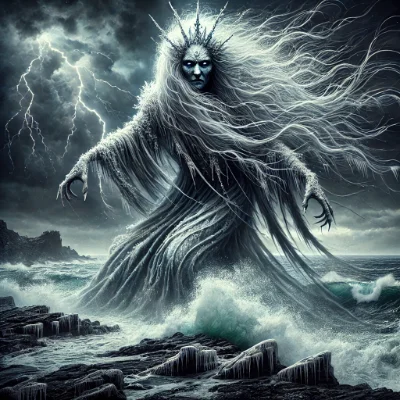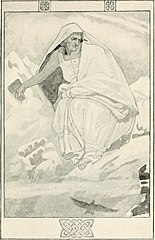Ireland’s Legend of the Winter Hag
Winter can be challenging—dark nights, biting cold, and nature seemingly asleep. But in Gaelic folklore, winter has a guardian: the Cailleach. Known as “The Winter Hag,” she’s an ancient figure who embodies the power of the cold season. This post will explore who Cailleach is, where her stories come from, and why they still fascinate us today.
What Does “Cailleach” Mean?

The name Cailleach comes from an Old Gaelic word meaning “old woman” or “hag.” Sometimes called the “Veiled One,” she’s associated with mystery and hidden knowledge. You may also hear her referred to by other names—like the Blue Hag or, in Ireland, the Hag of Beara. No matter the name, she’s always linked to the wintery side of nature in Celtic myths throughout Scotland, Ireland, and other Gaelic-speaking areas.
Origins of the Myth
The Cailleach’s roots stretch deep into pre-Christian Celtic folklore. Early communities in these regions relied heavily on the land and weather, so they explained natural forces through the stories of gods, goddesses, and mythical beings. The Cailleach was one such being, representing the dark and stormy part of the year and symbolizing how necessary cold and rest are for the land’s renewal cycle.
Characteristics of the Cailleach
- Appearance: She is usually imagined as a tall, old woman or crone. Some tales describe her with a blueish or grey tinge to her skin, reflecting the cold, icy landscape she commands.
- Powers: As a winter deity, she controls storms, wind, and snow. She’s often seen with a staff or hammer she uses to strike the ground and freeze it.
- Associations: She’s strongly connected to barren landscapes, the biting cold, and the transformative power of winter.
Stories and Legends

- Shaper of the Land: Many myths say the Cailleach created mountains, hills, and lakes by dropping rocks or carving out valleys. In Scotland, she’s sometimes credited with forming the Highlands.
- Seasonal Cycle: She rules from late autumn through winter and then steps aside when spring arrives. She is usually represented by a younger, sun-linked goddess like Brigid in Ireland or Bride in Scotland.
- Cultural Variations: Legends differ between regions. In some tales, the Cailleach has more human-like traits and appears in local village stories; in others, she is a powerful deity who roams wild and free.
The Cailleach and the Wheel of the Year
Gaelic festivals mark different points in the changing seasons. Two key dates for the Cailleach’s power are:
- Samhain (October 31): The start of the dark half of the year, when her influence begins to grow.
- Imbolc (February 1): A festival of light and the approaching spring. The Cailleach’s hold loosens as the world warms, sometimes said to coincide with her transformation into a youthful maiden.
This theme of dark turning to light is common in many cultures. Still, Cailleach’s story vividly portrays winter’s role in renewing the land.
Modern Interpretations
- Triple Goddess: In some modern Pagan traditions, the Cailleach represents the “Crone” aspect of the Triple Goddess (Maiden, Mother, Crone). She embodies wisdom, endings, and the final cycle before rebirth.
- Environmental Symbol: Many people today see her as a reminder of nature’s raw power. Although the cold season can be harsh, it’s essential to the earth’s balance.
- Folklore Revival: Celtic myths have renewed interest, with the Cailleach drawing attention for her fierce independence and deep connection to the land.

Why Her Story Endures
Even centuries later, Cailleach’s myth resonates because it speaks to the heart of human experience. We all face periods of darkness, dormancy, and waiting. The Cailleach teaches that these times are not just to be endured but respected and embraced because they lay the groundwork for renewal and growth. Her legend reminds us of our deep links to nature’s rhythms—an essential message in our modern, fast-paced world.
Conclusion
In the cycle of the seasons, winter can seem challenging and endless. Yet the Cailleach, the Winter Hag, symbolizes the necessary stillness and cleansing that winter brings—preparing the land and our spirits for the coming spring. As you encounter wintry weather and shorter days, perhaps you’ll think of the Cailleach and find value in winter’s unique power and beauty.
Do you have a favourite winter myth or story? Share it below!
We’d love to hear your thoughts about how folklore connects us to the changing seasons. If you’re curious to learn more about Celtic folklore, look for local storytelling events or dive into a book on Gaelic mythology—a rich world full of deities, heroes, and tales that endure to this day.
